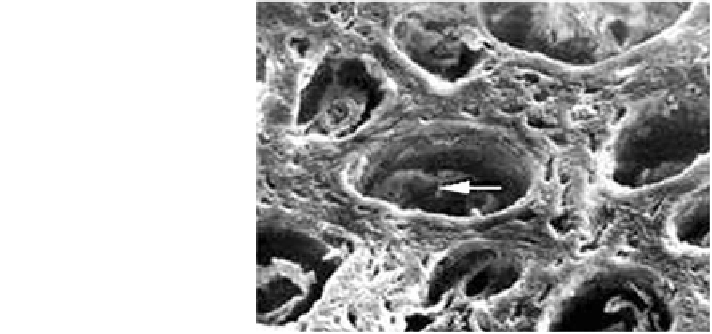Biomedical Engineering Reference
In-Depth Information
Fig. 2 Newly formed vessels
in the distraction regenerate,
electron micrograph x500
[
57
]
2.2 Impact on Tissue Engineering and Regeneration
The majority of fractures heal well under standard conservative or surgical
therapy. However extended bone defects following trauma or cancer resection or
non-union of fractures may require more sophisticated treatment. In these cases,
bone grafting procedures, segmental bone transport, distraction osteogenesis or
biomaterials are applied for reconstruction [
65
]. In all these processes, the impact
of angiogenesis on bone regeneration is crucial. For instance, in the United States
5-10 % (250,000-500,000) of fractures go onto nonunion or delayed union [
104
].
Negative effects on the vascular system might be the mechanism whereby many
other risk factors delay or impair bone healing [
48
]. In distraction osteogenesis
many studies have suggested that blood supply has a significant influence on the
shape and mass of the resulting bone [
3
,
55
]. If blood supply is inadequate to
support normal or increased mechanical loading, then the bone cannot respond
favorably, leading to atrophic or degenerative changes. By contrast, if blood
supply is adequate to support increased mechanical loading, the bone will dem-
onstrate compensatory hypertrophic changes. This has motivated efforts aimed at
better understanding the vasculature around fractures/osteotomies, as well as
advancing in the therapeutic measures that may improve these processes.
Regarding wound healing, chronic wounds represent a major public health
problem affecting 6.5 million people in the United States. Chronic wounds, such as
pressure or venous ulcers, are frequently suffered by patients with diabetes and
obesity. Treating chronic wounds costs an estimated US$25 billion each year and
is growing rapidly due to increasing health care costs, an aging population and a
rise in the incidence of diabetes and obesity worldwide [
111
]. Ischemia, which
does not fall into the category of chronic wound and is primarily caused by
peripheral artery diseases, also represents a major complicating factor in cutaneous
wound healing [
124
].

Search WWH ::

Custom Search